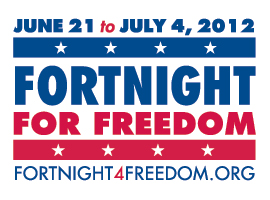Religion and Politics – A Polite Conversation
 You know the old saw about not bringing up religion and politics in polite company? Well, I’m going to bring up both, as we have just entered the second annual Fortnight for Freedom. The U. S. Conference of Catholic Bishops has again called for two weeks of prayer and action to address many current challenges to religious liberty. As Catholics, how do these two facets of our lives intersect?
You know the old saw about not bringing up religion and politics in polite company? Well, I’m going to bring up both, as we have just entered the second annual Fortnight for Freedom. The U. S. Conference of Catholic Bishops has again called for two weeks of prayer and action to address many current challenges to religious liberty. As Catholics, how do these two facets of our lives intersect?
Last year, a few days after the election, I attended an evening presentation by Archbishop Charles Thompson of Evansville, Indiana. He opened his remarks by relating an encounter with one of his archdiocesan priests who had asked how he was to comfort parishioners distressed with the outcome of the election. His response was something to the effect of, “I was upset when I woke up and heard the results, too.” He paused, then added, “Of course, as a Catholic, I would have been just as upset no matter who won.”
That is the only statement I remember from the whole evening.
Political parties and governments are man-made, not God-created. Therefore, no party will embrace the full truth Christ preached. Yet, I know staunch Democrats and staunch Republicans who cannot fathom being Catholic without being a diehard member of their party.
A year ago, I believed that all Catholics knew more about their faith than I did. I am a convert, granted, from some thirty years ago, but the instruction I received prior to becoming Catholic was pretty spotty. To me, ‘conversion’ was nothing more than attending a different church – one with lots more ritual than I was used to, but hey. No biggie. Years passed. Then I encountered my first anti-Catholic sentiment. This was a turning point. I realized I was poorly equipped to explain my faith, which had quietly become the basis of who I am. I poured my energies into learning about the reasons behind all those ‘unreasonable’ tenets held by Catholics. This is not to say that I don’t struggle, because there are some teachings that are hard for me. But rather than turn my back on the Church, I have learned to accept some mystery.
I have come to realize that many of us (Catholics) do not understand, much less embrace, those core beliefs. Regular readers of this blog likely do, but the average Catholic, maybe not so much. And this is why our government, elected by us, is able to erode our freedom of religious liberty.
What steps are necessary to reclaim and restore those freedoms?
Remember (or perhaps understand) that as Catholics, we do not hold to a single conversion experience; rather, our lives are a continual conversion toward God. Moment by moment, we conform to His image, His reasoning. This is an ongoing, life-long process. With that in mind, we can do some of the following:
First, pray. Then pray. And last, pray. Pray for ourselves, that we become more Christ-like in our hearts, so that we can carry out the work of His kingdom within our sphere of influence. Pray for our leaders, both in the Church and in the government, that all will work for the good of the poor and the oppressed. Pray for those we don’t understand; pray for our enemies. Often, when we open ourselves to listening to others, we discover we have far more in common than we have differences.
Catechize ourselves. If you don’t understand why the Church teaches against contraception, read Pope John Paul II’s Theology of the Body. An excellent resource in understanding the Bible itself is Jeff Cavins’ Great Adventure Bible Timeline series. Have you read the Catechism of the Catholic Church? I highly recommend it. In the past, I had used my Catechism like a dictionary. Have a question? Find the topic in the Catechism, look it up, and read two or three paragraphs about the subject. But the document is so much more than that. It is compassion, it is clear, it is welcoming. It explains the faith without judgment or apology. It invites.
Catechize those around us. When those uncomfortable subjects come up around the water cooler or in the break room, you’ll be in the unique position of being a myth-buster. Who knows? Maybe your spontaneous comment will be the one that stays with someone for months, and motivates them to learn more or reevaluate their thinking. Don’t forget your family and your faith community. We are all at different stages in our journeys, and we have much to learn from each other.
Vote. Educate yourself. Then vote your conscience.
Write your congressman and senators, at state and federal levels. It’s easy to do, especially now that their offices accept email. I’ve become a letter writer. That use of my God-given talent may be the most important. Only He knows. Write a letter to the editor of your local newspaper. Write an encouraging note to a friend.
Most of all, love. A joyful, listening heart is what we all long for, and will open more doors than any of our words.
You’ll notice that my approach to the Fortnight for Freedom begins at home, within each one of us. Our faith was never meant to stay there, though. Ships are not built for the harbor, but for the challenges of the open seas. Such is our faith.
Make sure your ship is seaworthy, and go. Become a fisher of souls.








 The United States was founded by numerous groups fleeing Europe in search of the freedom to practice their religion, free from tyranny or persecution. Now, after hundreds of years, our government – once envisioned to be a tool to protect those freedoms – has seen fit to attempt to restrict the practice of specific Catholic beliefs. Many other Christian people recognize this assault on freedom of religion, and stand in solidarity with us.
The United States was founded by numerous groups fleeing Europe in search of the freedom to practice their religion, free from tyranny or persecution. Now, after hundreds of years, our government – once envisioned to be a tool to protect those freedoms – has seen fit to attempt to restrict the practice of specific Catholic beliefs. Many other Christian people recognize this assault on freedom of religion, and stand in solidarity with us.